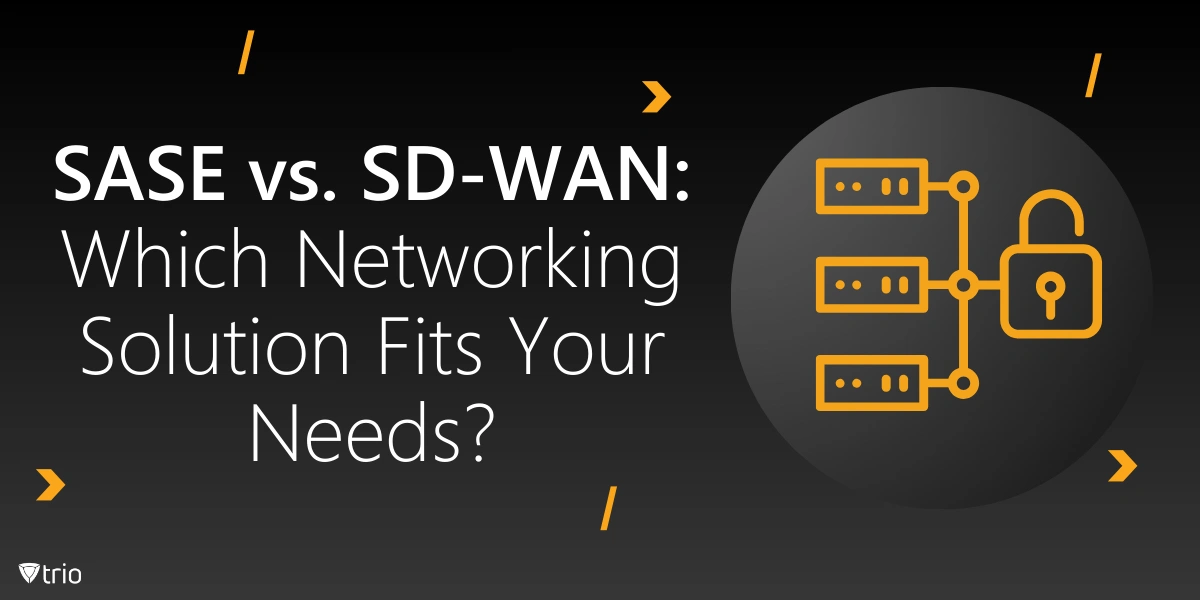In the current era of digital transformation, where remote work, cloud computing, and data security are top priorities, businesses face the challenge of maintaining high-performance networks while ensuring robust security. To meet these demands, many organizations turn to Secure Access Service Edge (SASE) and Software-Defined Wide Area Network (SD-WAN) as solutions that combine connectivity and security. Each approach offers unique strengths for supporting modern, distributed workforces and delivering secure, reliable access. This blog post explores SASE vs. SD-WAN, covering their pros and cons, security features, and how each meets evolving connectivity and security needs.
Understanding SASE and SD-WAN: Key Components of Modern Networks
While both networks have distinct strengths, the choice between SASE and SD-WAN depends on your organization’s goals, existing infrastructure, and long-term needs. Understanding the core components and functions of each can help you make an informed decision that supports both operational efficiency and security.
Secure Access Service Edge (SASE) Overview
Secure Access Service Edge, or SASE, is a networking framework that combines wide-area networking (WAN) capabilities with cloud-native security services. This approach streamlines network and security services, making it ideal for companies with a large number of remote users. A key component of SASE architecture is the Security Service Edge (SSE), which incorporates services like firewall as a service (FWaaS), secure web gateway (SWG), and cloud access security broker (CASB). Together, these elements deliver access security and support secure, real-time connectivity across distributed environments.
Software-Defined Wide Area Network (SD-WAN) Overview
Software-Defined Wide Area Network, or SD-WAN, revolutionizes traditional networks by using software to manage WAN connections, allowing for centralized control and improved efficiency. Unlike traditional networks, which rely heavily on dedicated hardware, SD-WAN dynamically routes traffic across various transport options, such as broadband, Multi-Protocol Label Switching (MPLS), and Long Term Evolution (LTE). This allows for high performance, particularly in applications requiring low latency and reliable connectivity. SD-WAN is often praised for its cost-effective approach and scalability, supporting cloud-first initiatives without the need for extensive physical infrastructure.

Difference Between SASE and SD-WAN: Core Functions and Architecture
When evaluating SASE and SD-WAN, it’s essential to understand their distinct core functions and architectural approaches. While both solutions aim to enhance network performance and security, they do so in different ways that cater to varying organizational needs.
Core Architecture and Security Focus
At its core, SD-WAN focuses on managing and optimizing network connectivity across a defined wide area network. Its main function is to ensure high-performance and cost-effective WAN connections, making it ideal for sites that need reliable access to centralized resources. In contrast, SASE combines SD-WAN-like capabilities with integrated security features. The SASE architecture merges networking functions with security, aiming to provide a secure framework for companies transitioning to cloud-based and hybrid environments. It’s important to note that while SASE encompasses both networking and security elements, SSE is a component of SASE that is strictly focused on security. SSE delivers essential services such as network access control through tools like CASB and SWG, but it does not include the network optimization features inherent in SASE.
Built-In Security Features
SASE is designed with security at the forefront, incorporating a zero trust architecture that provides granular access control. In contrast, SD-WAN’s security features are typically limited to basic encryption and traffic segmentation. Although SD-WAN can integrate with external security services, it does not inherently include a strong security stack like SASE does. SASE’s security stack ensures safe and reliable connectivity for remote workers, while SD-WAN primarily addresses the connectivity aspect, leaving organizations to manage security through additional solutions. Furthermore, ZTNA integration allows SASE to enhance security protocols by authenticating users and devices based on strict criteria.
SASE vs. SD-WAN Pros and Cons: Deciding on the Right Solution
When choosing between SASE and SD-WAN, it’s crucial to weigh their respective pros and cons to determine which solution aligns best with your organization’s specific needs.
SASE Pros and Cons
One of the biggest strengths of SASE is its focus on comprehensive security, blending connectivity with security features like CASB and SWG to create a secure web environment for all users. Additionally, SASE’s architecture supports global scalability, making it highly suitable for companies with distributed workforces. However, SASE can be complex to implement and may require significant investment, particularly for companies not yet cloud-centric. Its cloud-based nature also raises potential latency issues for organizations with high on-premises dependencies. Moreover, its integration of ZTNA Solutions reinforces its security measures, ensuring only authorized users have access to sensitive data.
SD-WAN Pros and Cons
SD-WAN excels in scenarios requiring high-performance WAN connectivity with optimized traffic routing. The flexibility to utilize various connection types, such as MPLS or broadband, allows companies to achieve cost savings and better network efficiency. Despite its benefits, SD-WAN security is often a limitation; its focus on WAN optimization does not inherently include security capabilities. To address this, companies must add external security layers, which can complicate deployment and increase operational overhead. Organizations utilizing SD-WAN must also consider how they will implement a zero trust vs. VPN strategy to ensure that their data remains protected.
The Security Side of SASE and SD-WAN
One of SASE’s strongest assets is its zero-trust network access (ZTNA) approach, which grants access only to authenticated and authorized users, reinforcing security in remote work settings. Through trust network access, or ZTNA, SASE restricts access to applications based on identity, reducing risks associated with unauthorized access. To support this approach, organizations can utilize the Kipling Method, which emphasizes asking six essential questions—what, why, when, how, where, and who—allowing teams to thoroughly analyze security needs and implement effective zero trust strategies. For remote workers and cloud-based environments, this approach significantly enhances protection.
While SD-WAN’s main purpose is to deliver optimal performance, it lacks comprehensive built-in security. Instead, SD-WAN relies on add-ons or integrations with existing security solutions to meet security needs. While this flexibility can work well for companies focusing on network efficiency, it can expose them to risks if not adequately managed. For companies prioritizing security, SASE’s built-in security features make it the more appealing choice.

Supporting Digital Transformation: Choosing Between SASE and SD-WAN
For companies that have transitioned or are in the process of shifting to the cloud, SASE’s alignment with cloud-native security frameworks makes it a strong contender. Access service edge SASE models integrate security seamlessly into the network, supporting scalable and flexible growth. As digital transformation progresses, many organizations see SASE as the ideal solution for reducing complexity while enhancing security for remote users and distributed teams.
For organizations with a heavy reliance on traditional networks or on-premises setups, SD-WAN provides a cost-effective way to enhance network performance. This defined wide area network solution is particularly useful for locations needing stable, high-speed connections. Companies can achieve substantial cost savings without sacrificing quality, making SD-WAN suitable for those not yet fully committed to a cloud-first approach. Understanding the differences in approaches such as ZTNA vs. SASE vs. CASB can further guide organizations in making informed decisions about their network security frameworks.
Trio’s Role in SASE vs. SD-WAN: Enabling Smart MDM Solutions
As organizations consider SASE and SD-WAN, device management also plays a crucial role in maintaining a secure and efficient network. Trio’s Mobile Device Management (MDM) solution enhances both SASE and SD-WAN environments by offering centralized management and control over all connected devices. With Trio, companies can streamline network security, track device activity, and ensure compliance with security policies across devices in real time. Trio’s MDM solution provides an added layer of security, ensuring that mobile devices in any WAN or SASE architecture remain protected.
Take your network’s security and performance to the next level with Trio’s MDM solution. Book your free demo today!
SASE vs. SD-WAN—The Future of Networking is Flexible
While both SASE and SD-WAN offer distinct advantages, the choice depends on your organization’s unique needs and goals. If cloud security and seamless integration are top priorities, SASE provides a robust, all-in-one solution. For companies with traditional network structures seeking enhanced performance, SD-WAN delivers high-performance connectivity. With the right solution in place, your organization can stay agile, secure, and prepared for the future of networking.
Know about news
in your inbox
Our newsletter is the perfect way to stay informed about the latest updates,
features, and news related to our mobile device management software.
Subscribe today to stay in the know and get the most out of your mobile
devices with our MDM solution app.
Recent Posts

Erase the Risk: Protect with Zero Standing Privileges
Learn how zero standing privileges eliminate persistent access rights, enhance data security and reduce the risk of unauthorized access.

Understanding Access Control Types in Cybersecurity w/ Examples
Thorough understanding of access control types & the knowledge to make informed decisions about implementing security measures in your organization.

Cloud Data Protection: Safeguarding Information in the Cloud
Learn essential strategies for robust cloud data protection, exploring tools, best practices, and policies that safeguard sensitive information.





